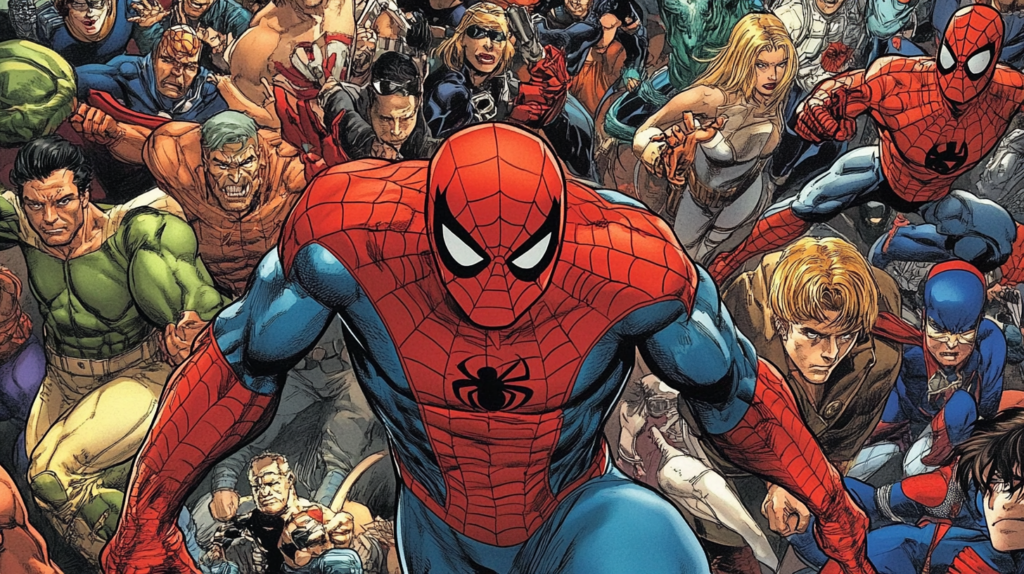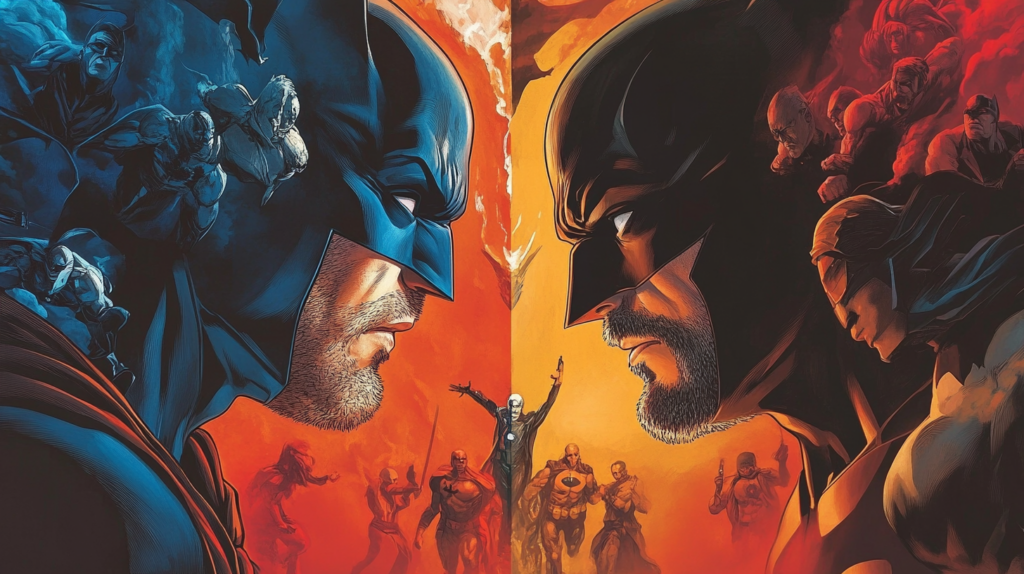Graphic Novels vs. Comic Books: Graphic novels and comic books are two closely related forms of storytelling that have had a significant impact on pop culture. While they share many similarities, such as their use of sequential art and a blend of text and visuals, they also have distinct differences that have contributed to their unique places in popular culture. Understanding the differences between graphic novels and comic books—and the reasons behind their popularity—reveals how these mediums have evolved and continue to thrive. Let’s explore the surprising truth behind the popularity of graphic novels and comic books.

1. Defining Graphic Novels and Comic Books
What Is a Comic Book?
- Serialized Format: Comic books are typically released in a serialized format, with individual issues coming out periodically (often monthly). These issues are usually shorter, around 20-30 pages, and contain parts of a larger ongoing story or self-contained adventures.
- Genre Diversity: While superhero stories have dominated the comic book industry, especially in the U.S., comic books cover a wide range of genres, including science fiction, fantasy, horror, and slice-of-life narratives.
- American Origins: Comic books, as we know them today, originated in the United States in the early 20th century, with Action Comics #1 (featuring Superman) being one of the most significant early issues. This format has traditionally been associated with superhero narratives, though it has expanded to include many other genres over time.

What Is a Graphic Novel?
- Diverse Topics and Styles: Graphic novels often explore a wider variety of themes and topics than traditional comic books, delving into complex issues such as politics, personal identity, history, and social justice. Popular graphic novels like Maus, Persepolis, and Blankets have pushed the boundaries of what the medium can explore.
- Complete Stories: Unlike comic books, graphic novels are typically longer, offering a complete story in a single volume. They are akin to novels but told through a combination of text and illustrations.
- Standalone or Series: While some graphic novels are standalone, many are part of a series, but each book usually presents a complete narrative arc. This differs from the episodic nature of comic books, which may require readers to follow multiple issues to get the whole story.

2. The Evolution of Comic Books and Their Popularity
The Golden Age of Comic Books
- Birth of Superheroes: The popularity of comic books skyrocketed during the Golden Age (late 1930s to early 1950s) with the creation of iconic superheroes like Superman, Batman, Wonder Woman, and Captain America. These characters represented hope and strength during times of war and social change, cementing the superhero genre as a cornerstone of comic book culture.
- Serialized Adventures: Comic books’ serialized format allowed readers to follow their favorite characters through ongoing adventures, fostering loyalty and anticipation for the next issue. This episodic structure gave rise to fan communities and the first signs of comic book fandom.
Silver and Bronze Ages of Comics
- Social Relevance: During the Silver Age (mid-1950s to 1970) and Bronze Age (1970s to early 1980s), comic books began addressing more mature and socially relevant themes. Issues like drug addiction, race relations, and political corruption were tackled in superhero narratives, helping comic books gain a more complex and serious reputation.
- Expansion of Genres: While superhero comics remained dominant, other genres such as horror, crime, and romance gained traction, broadening the appeal of comic books to different audiences.
The Rise of Comic Book Fandom
- Blockbuster Movies: The surge in superhero films, particularly through the Marvel Cinematic Universe (MCU) and DC Extended Universe (DCEU), has rekindled interest in comic books, driving their popularity to new heights. Many readers flock to comic books to explore the original stories behind their favorite cinematic heroes.
- Comic Conventions and Collecting: As comic book culture grew, so did the fanbase. Comic conventions, like San Diego Comic-Con, started as small gatherings for comic book fans but have since evolved into massive pop culture events. The collectible nature of comic books, with certain issues becoming rare and valuable, has also contributed to their enduring appeal.
3. The Graphic Novel Boom and Its Growing Popularity
Graphic Novels as Literary Art
- Recognition as Literature: Graphic novels have gained significant literary recognition, often being seen as more sophisticated and complex than their comic book counterparts. Works like Art Spiegelman’s Maus (which won a Pulitzer Prize) and Marjane Satrapi’s Persepolis are now studied in academic settings, bridging the gap between visual storytelling and traditional literature.
- Tackling Serious Themes: Graphic novels are known for tackling serious and often personal subjects. From political commentary to autobiographical accounts, the medium has allowed creators to tell more introspective and complex stories. For example, Fun Home by Alison Bechdel explores themes of identity, family, and LGBTQ+ issues, while Joe Sacco’s Palestine delves into the Israeli-Palestinian conflict.

Appeal to a Broader Audience
- Non-Superhero Stories: Unlike comic books, which are often associated with superheroes, graphic novels explore a wide range of genres and topics, making them accessible to a broader audience. This diversity in storytelling appeals to readers who may not be interested in traditional comic book fare.
- Crossover Appeal: Many people who do not identify as comic book fans are drawn to graphic novels because they are often marketed as standalone literary works. This has helped graphic novels reach new audiences, including adults who might not otherwise engage with comics.
Graphic Novels in Education
- Accessible Storytelling: Graphic novels often present complex subjects in an accessible format, making them appealing to reluctant readers, young adults, or people who struggle with traditional text-heavy books. The combination of visuals and words makes difficult topics more understandable and engaging.
- Used in Classrooms: Graphic novels have increasingly found their way into classrooms, both as teaching tools and as part of literature curricula. Books like Persepolis, American Born Chinese, and March (John Lewis’s memoir of the Civil Rights Movement) are widely used in schools to engage students with history, social issues, and personal narratives in a visually compelling way.

4. The Differences in Popularity: Why They Matter
Comic Books: Nostalgia and Fandom
- Nostalgic Appeal: One of the reasons comic books remain popular is their nostalgic appeal. For many readers, comic books are a link to their childhood or teenage years, evoking a sense of continuity with past generations of fans.
- Dedicated Fandom: The serial nature of comic books fosters dedicated fanbases that actively engage with ongoing stories. Readers often collect issues, follow crossovers, and participate in fan communities, creating a sense of loyalty and involvement that graphic novels, with their more finite stories, may not always cultivate.
- Blockbuster Influence: The success of comic book-inspired films and TV shows continues to draw new readers to comic books, reinforcing the popularity of superhero narratives in particular. Fans of the MCU or DCEU often dive into comic books to explore the source material, keeping these stories alive and relevant.
Graphic Novels: Literary Prestige and Broader Appeal
- Genre Diversity: Graphic novels often explore more diverse themes and genres than comic books, including memoirs, historical fiction, horror, and even philosophy. This variety has allowed graphic novels to reach readers who might not be drawn to the superhero-dominated world of comic books.
- Critical Acclaim: Graphic novels have earned critical recognition and literary awards, which has given them a level of prestige that comic books traditionally lacked. This legitimacy has opened doors for graphic novels to be considered “serious” literature, appealing to a wider demographic, including adults and academic readers.
- Self-Contained Stories: The self-contained nature of many graphic novels appeals to readers who prefer to engage with complete stories rather than following a series over time. This accessibility, combined with the diverse genres available, makes graphic novels attractive to casual readers as well as those looking for something more substantive.

5. Story Complexity and Themes
While comic books have historically been associated with superhero tales, the scope of graphic and comic books has expanded to include a wide range of genres and themes. Graphic novels, in particular, are known for their diversity in storytelling, encompassing genres such as memoir, historical fiction, fantasy, and more. Creators of graphic novels often have the space to explore intricate plots, character development, and complex themes.
Due to their serialized nature, comic books may sometimes face constraints in terms of story complexity. However, this format’s periodic nature also allows for ongoing character development and exploring various story arcs.

6. Artistic Style and Presentation
Both graphic novels and comic books rely on a combination of visuals and text to convey their narratives, but there can be differences in artistic style and presentation. Graphic novels often feature a more extensive use of panel layouts, allowing for a slower, more deliberate pace of storytelling. The artwork in graphic novels is typically more detailed, with creators having the opportunity to craft intricate visual narratives.
Given their shorter format and serialized nature, comic books may feature more dynamic and action-oriented panel layouts. The focus on maintaining reader engagement within a limited space can result in more condensed visual storytelling.

7. The Convergence of Comic Books and Graphic Novels
Blurring the Lines Between Formats
- Superhero Graphic Novels: Graphic novels are not limited to non-superhero content. Stories like Watchmen by Alan Moore and Dave Gibbons, and The Dark Knight Returns by Frank Miller, have elevated superhero narratives into the realm of graphic novels, combining the best of both worlds and appealing to a broader audience.
- Collected Editions: Many comic book series are now collected into graphic novel-like volumes (known as trade paperbacks), allowing readers to consume entire story arcs in a single book. This blurring of the lines between comic books and graphic novels has helped both formats grow in popularity, as readers can engage with stories in the format that suits them best.

The Surprising Truth Behind Their Popularity
The popularity of graphic novels and comic books lies in their ability to captivate audiences with engaging stories and stunning visuals, while also reflecting the evolution of popular culture and society. Comic books, driven by serial storytelling and dedicated fanbases, maintain their iconic status in the world of superheroes and adventure. On the other hand, graphic novels have carved out a unique space by offering complete, self-contained stories that explore a wide range of genres and themes, appealing to a diverse and often more literary audience.
Ultimately, both mediums continue to thrive because they offer something for everyone—from casual readers to dedicated fans—and their cultural impact is undeniable. Whether you’re drawn to the ongoing adventures of comic books or the depth and literary value of graphic novels, both forms of storytelling are powerful, relevant, and here to stay.
Read also
- The Role of Graphic Novels in Education: Improving Literacy and Visual Literacy
- From Page to Screen: The Challenges of Adapting Graphic Novels into Films
- The Art of Visual Storytelling: How Graphic Novels Impact Literature
- Exploring the Influence of Graphic Novels on Modern Pop Culture
Frequently Asked Questions: Graphic Novels vs. Comic Books
What is the difference between a graphic novel and a comic book?
- Format: Graphic novels are typically longer, self-contained works that tell a complete story, while comic books are shorter and usually part of an ongoing series with periodic issues.
- Structure: Graphic novels often follow a more traditional narrative arc, whereas comic books frequently feature serialized storytelling with cliffhangers or continued plotlines across multiple issues.
Are the art styles in graphic novels and comic books different?
- Graphic Novels: The art in graphic novels can vary widely depending on the tone and genre, ranging from detailed, realistic illustrations to more stylized or abstract designs.
- Comic Books: Comic book art tends to follow certain genre conventions, especially in superhero comics, which often feature bold colors, dynamic action, and exaggerated anatomy. However, independent and alternative comics may break these conventions.
How are graphic novels and comic books published and distributed?
- Graphic Novels: Typically published as a single volume or in limited series, graphic novels are available in bookstores, libraries, and online retailers. They are often bound like traditional books.
- Comic Books: Released in serialized issues, comic books are typically sold in specialty comic book stores, newsstands, and digital platforms. Comic book series are often collected into trade paperbacks once several issues have been published.
Which medium is more suitable for deeper or more complex storytelling?
- Graphic Novels: Due to their length and structure, graphic novels often allow for more complex narratives and character development. They are frequently used to explore mature themes or tell complete, stand-alone stories.
- Comic Books: While comic books can also explore deep themes, their episodic nature means that stories are often spread out over several issues, and they may focus more on action and plot advancement within each individual issue.
Are graphic novels and comic books meant for different audiences?
- Graphic Novels: Graphic novels often target a broader audience, including children, young adults, and mature readers. They cover a wide range of genres such as fantasy, memoir, history, and literary fiction.
- Comic Books: Traditionally, comic books were associated with younger audiences and the superhero genre, but today they cater to a wide variety of readers, including adults, with genres spanning from horror and sci-fi to romance and political commentary.
Which is more accessible for new readers: graphic novels or comic books?
- Graphic Novels: Graphic novels are more accessible to new readers since they usually contain a complete story in one volume, requiring no prior knowledge of characters or plotlines.
- Comic Books: Comic books, particularly those in long-running series like Marvel or DC titles, may be harder for new readers to jump into as they often require familiarity with ongoing storylines or character backstories.
Can graphic novels and comic books be adapted into other media?
Yes: Both graphic novels and comic books have been successfully adapted into films, TV shows, and video games. Graphic novels like “Watchmen” and “Persepolis” have inspired films, while comic books like “Spider-Man” and “Batman” have spawned numerous media adaptations.
What are some examples of notable graphic novels and comic books?
Graphic Novels:
- “Maus” by Art Spiegelman: A Pulitzer Prize-winning graphic novel about the Holocaust.
- “Persepolis” by Marjane Satrapi: An autobiographical graphic novel about growing up in Iran during and after the Islamic Revolution.
- “Sandman” by Neil Gaiman: A genre-defying series often categorized as a graphic novel for its thematic depth.
Comic Books:
- “Batman: The Dark Knight Returns” by Frank Miller: A highly influential Batman series.
- “Spider-Man” by Stan Lee and Steve Ditko: One of the most iconic comic book series of all time.
- “X-Men” by Marvel Comics: Known for exploring themes of identity, diversity, and social justice.
Which medium is more popular today, graphic novels or comic books?
- Graphic Novels: Graphic novels have seen a significant rise in popularity, especially among younger readers and in educational settings. They are increasingly recognized as literary works and often reviewed in mainstream media.
- Comic Books: While comic book sales have declined in certain traditional markets, superhero comics, in particular, remain hugely popular, especially with the success of blockbuster film franchises based on these characters.
Is one format more respected or legitimate as an art form than the other?
No: Both graphic novels and comic books are respected as legitimate art forms. While graphic novels were historically seen as more literary or serious, the perception of comic books has evolved, and both formats are now recognized for their storytelling, artistic merit, and cultural impact.
This post was created with our nice and easy submission form. Create your post!





6 Comments